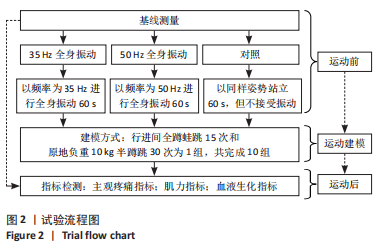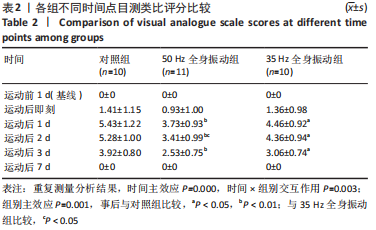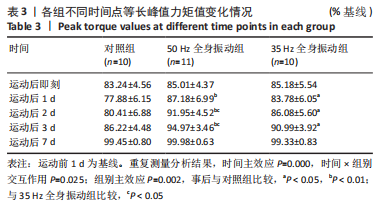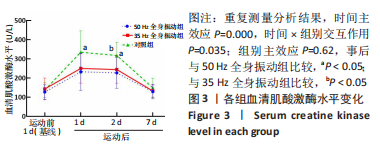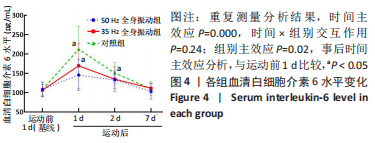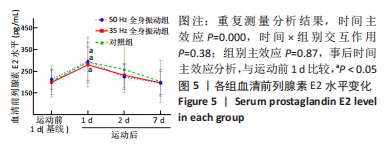Chinese Journal of Tissue Engineering Research ›› 2023, Vol. 27 ›› Issue (32): 5085-5090.doi: 10.12307/2023.822
Improvement of delayed-onset muscle soreness by pre-exercise whole-body vibration at 50 Hz
Zhang Xuebin, Ao Wenjun, Jiang Xin, Song Chenglin
- Shenyang Sport University, Shenyang 110102, Liaoning Province, China
-
Online:2023-11-18Published:2023-03-22 -
Contact:张学彬,男,1989年生,山东省禹城县人,汉族,沈阳体育学院在读硕士,主管技师(康复医学治疗技术),主要从事运动康复方面的研究。 -
About author:Zhang Xuebin, Master candidate, Technician-in-charge, Shenyang Sport University, Shenyang 110102, Liaoning Province, China -
Supported by:2021 Science and Technology Research Project of Liaoning Disabled Persons' Federation, No. SK2020299 (to SCL)
CLC Number:
Cite this article
Zhang Xuebin, Ao Wenjun, Jiang Xin, Song Chenglin. Improvement of delayed-onset muscle soreness by pre-exercise whole-body vibration at 50 Hz[J]. Chinese Journal of Tissue Engineering Research, 2023, 27(32): 5085-5090.
share this article
Add to citation manager EndNote|Reference Manager|ProCite|BibTeX|RefWorks
| [1] PRIEGO-QUESADA JI, DE LA FUENTE C, KUNZLER MR, et al. Relationship between Skin Temperature, Electrical Manifestations of Muscle Fatigue, and Exercise-Induced Delayed Onset Muscle Soreness for Dynamic Contractions: A Preliminary Study. Int J Environ Res Public Health. 2020; 17(18):6817. [2] 汪军, 周越, 孙君志, 等. 质疑与思考:运动生理学研究的十个问题[J]. 成都体育学院学报,2021,47(1):118-124. [3] 张国海, 王人卫. 肌内效贴对延迟性肌肉酸痛和肌肉功能恢复的影响[J]. 体育科学,2017,37(12):46-51. [4] MUELLER-WOHLFAHRT H, HAENSEL L, MITHOEFER K, et al. Terminology and classification of muscle injuries in sport: The Munich consensus statement. Br J Sports Med. 2013;47(6):342-350. [5] WUESTEFELD A, FUERMAIER ABM, BERNARDO-FILHO M, et al. Towards reporting guidelines of research using whole-body vibration as training or treatment regimen in human subjects—A Delphi consensus study. PLOS ONE. 2020;15(7):e235905. [6] AMINIAN-FAR A, HADIAN M, OLYAEI G, et al. Whole-body vibration and the prevention and treatment of delayed-onset muscle soreness. J Athl Train. 2011;46(1):43-49. [7] MAGOFFIN RD, PARCELL AC, HYLDAHL RD, et al. Whole-Body Vibration as a Warm-up Before Exercise-Induced Muscle Damage on Symptoms of Delayed-Onset Muscle Soreness in Trained Subjects. J Strength Cond Res. 2020;34(4):1123-1132. [8] TAN J, SHI X, WITCHALLS J, et al. Effects of Pre-exercise Acute Vibration Training on Symptoms of Exercise-Induced Muscle Damage. J Strength Cond Res. 2022;36(8):2339-2348. [9] 钟国友. 振动刺激附加肌内效贴治疗运动性膝关节延迟性肌肉酸痛[J]. 中国组织工程研究,2019,23(27):4305-4309. [10] 邱俊强, 耿国强, 潘阳梦柔. 支链氨基酸联合葡萄糖补充时机对大强度离心运动后延迟性肌肉酸痛及相关指标的影响[J]. 中国体育科技,2019,55(3):66-72. [11] 邹亮畴. 非极限负荷气动变阻力量训练效果比较分析[C].广东省体育科学学会第二届体育科学大会, 中国广东广州,2007. [12] VAN MELICK N, MEDDELER BM, HOOGEBOOM TJ, et al. How to determine leg dominance: The agreement between self-reported and observed performance in healthy adults. PLOS ONE. 2017;12(12): e189876. [13] HOHENAUER E, COSTELLO JT, DELIENS T, et al. Partial‐body cryotherapy (−135°C) and cold‐water immersion (10°C) after muscle damage in females. Scand J Med Sci Sports. 2020;30(3):485-495. [14] KOCH AJ, PEREIRA R, MACHADO M. The creatine kinase response to resistance exercise. J Musculoskelet Neuronal Interact. 2014;14(1): 68-77. [15] DOS SANTOS RS, VERAS FP, FERREIRA DW, et al. Involvement of the Hsp70/TLR4/IL‐6 and TNF‐α pathways in delayed‐onset muscle soreness. J Neurochem. 2020;155(1):29-44. [16] 王今越, 丁树哲, 刘伟, 等. 运动与IL-6的研究进展[J]. 体育科学, 2007(6):60-69. [17] OTA H, KATANOSAKA K, MURASE S, et al. EP2 receptor plays pivotal roles in generating mechanical hyperalgesia after lengthening contractions. Scand J Med Sci Sports. 2018;28(3):826-833. [18] Rondanelli M, Fossari F, Vecchio V, et al. Clinical trials on pain lowering effect of ginger: A narrative review. Phytother Res. 2020;34(11):2843-2856. [19] 朱晓凤. 不同频率全身振动训练对老年人平衡和核心稳定性的影响[J]. 中国康复理论与实践,2020,26(3):291-294. [20] PARADISIS GP, PAPPAS P, DALLAS G, et al. Acute Effects of Whole-Body Vibration Warm-up on Leg and Vertical Stiffness During Running. J Strength Cond Res. 2021;35(9):2433-2438. [21] CARDINALE M, BOSCO C. The use of vibration as an exercise intervention. Exerc Sport Sci Rev. 2003;31(1):3-7. [22] REHN B, LIDSTROM J, SKOGLUND J, et al. Effects on leg muscular performance from whole-body vibration exercise: a systematic review. Scand J Med Sci Sports. 2007;17(1):2-11. [23] 许智勇, 殷鑫, 黄强年, 等. 离心运动的特征和急性反应[J]. 中国组织工程研究,2018,22(16):2607-2612. [24] HOTFIEL T, FREIWALD J, HOPPE MW, et al. Advances in Delayed-Onset Muscle Soreness (DOMS): Part I: Pathogenesis and Diagnostics. Sportverletz Sportschaden. 2018;32(4):243-250. [25] LAU WY, NOSAKA K. Effect of vibration treatment on symptoms associated with eccentric exercise-induced muscle damage. Am J Phys Med Rehabil. 2011;90(8):648-657. [26] 李玉章. 全身振动训练的理论与实践[M]. 上海:第二军医大学出版社,2010. [27] KERSCHAN-SCHINDL K, GRAMPP S, HENK C, et al. Whole-body vibration exercise leads to alterations in muscle blood volume. Clin Physiol. 2001;21(3):377-382. [28] SA-CAPUTO D, PAINEIRAS-DOMINGOS L, CARVALHO-LIMA R, et al. Potential effects of whole-body vibration exercises on blood flow kinetics of different populations: a systematic review with a suitable approach. Afr J Tradit Complement Altern Med. 2017;14(4 Suppl): 41-51. [29] SOUZA-SILVA E, CHRISTENSEN SW, HIRATA RP, et al. Blood flow after contraction and cuff occlusion is reduced in subjects with muscle soreness after eccentric exercise. Scand J Med Sci Sports. 2018;28(1): 29-39. [30] 宋法明, 刘北湘. 全身振动介入静态伸展对离心运动后延迟性肌肉酸痛的影响研究[J]. 山东体育学院学报,2017,33(1):74-79. [31] 袁艳, 吴贻刚, 苏彦炬, 等. 振动频率和负荷重量对半蹲起大腿肌群表面肌电活动的影响[J]. 体育科学,2012,32(10):64-68. [32] RONNESTAD BR, ELLEFSEN S. The effects of adding different whole-body vibration frequencies to preconditioning exercise on subsequent sprint performance. J Strength Cond Res. 2011;25(12):3306-3310. [33] TURNER AP, SANDERSON MF, ATTWOOD LA. The Acute Effect of Different Frequencies of Whole-Body Vibration on Countermovement Jump Performance. J Strength Cond Res. 2011;25(6):1592-1597. [34] ABERCROMBY AF, AMONETTE WE, LAYNE CS, et al. Variation in neuromuscular responses during acute whole-body vibration exercise. Med Sci Sports Exerc. 2007;39(9):1642-1650. [35] 刘北湘, 刘晓亚, 戴玮. 振动频率影响肌肉力量振动训练效果的实验研究[J]. 成都体育学院学报,2016,42(3):111-115. |
| [1] | Li Chao, Zhang Peipei, Xu Mengting, Li Linlin, Ding Jiangtao, Liu Xihua, Bi Hongyan. Respiratory training improves morphological changes of the multifidus muscle in patients with chronic nonspecific lower back pain assessed by musculoskeletal ultrasound [J]. Chinese Journal of Tissue Engineering Research, 2023, 27(9): 1417-1421. |
| [2] | Zhang Qiming, Bao Sairong, Shan Sharui, Zhong Zhiliang, Liu Chunlong. Effect of deep muscle stimulation on muscle tone and stiffness of erector spinaes in patients with chronic nonspecific low back pain: a digital muscle testing [J]. Chinese Journal of Tissue Engineering Research, 2023, 27(8): 1250-1256. |
| [3] | Pan Weimin, Wang Bing, Han Yabing, Li Ting, Song Jiaqi, Qin Huasheng, Liu Yang. Effects of blood flow restriction training on muscle strength, muscle mass and physical performance in older adults: a Meta-analysis [J]. Chinese Journal of Tissue Engineering Research, 2023, 27(5): 805-812. |
| [4] | Liang Xiao, Zhao Panchao, Li Jiahui, Ji Zhongqiu, Jiang Guiping. Gait and biomechanical characteristics of lower limbs in multi-task walking of 4-6-year-old children [J]. Chinese Journal of Tissue Engineering Research, 2023, 27(4): 505-512. |
| [5] | Li Yaping, Liu Hong, Gao Zhen, Chen Xiaolin, Huang Wujie, Jiang Zheng. Three-dimensional motion analysis of lower limb biomechanical performance in Tai Chi practitioners accompanied by knee joint pain [J]. Chinese Journal of Tissue Engineering Research, 2023, 27(4): 520-526. |
| [6] | Wan Guoli, Shi Chenhui, Wang Weishan, Li Ang, Shi Xunda, Cai Yi. Retrospective analysis of the influencing factors of chronic pain after total knee arthroplasty [J]. Chinese Journal of Tissue Engineering Research, 2023, 27(4): 558-564. |
| [7] | Xu Yangyang, He Peiliang, Meng Qingqi, Li Siming. A meta-analysis of the effects of continuous adductor canal block and continuous femoral nerve block on early activity after knee arthroplasty [J]. Chinese Journal of Tissue Engineering Research, 2023, 27(4): 640-645. |
| [8] | Chai Hao, Yang Deyong, Zhang Lei, Shu Li. 3D printing personalized osteotomy guide technology versus conventional total knee arthroplasty on the accuracy of lower limb force alignment: a meta-analysis [J]. Chinese Journal of Tissue Engineering Research, 2023, 27(4): 646-654. |
| [9] | Cen Wanyi, Gong Yuxuan, Huang Zhendong, Hu Xinyu, Lin Jun, Que Kexin, Li Tailiang, Wang Runmei, Song Chengxian. Immediate effects of different training movements on inter-rectus distance in postpartum women: a high-frequency ultrasound observation [J]. Chinese Journal of Tissue Engineering Research, 2023, 27(32): 5091-5096. |
| [10] | Feng Ruibing, Huang Yong, Hu Hao, Wu Gang, Duan Xiaofeng, Li Chaowen. Analgesic effect and mechanism of icariin in a rat model of post-traumatic knee arthritis [J]. Chinese Journal of Tissue Engineering Research, 2023, 27(32): 5108-5113. |
| [11] | Zhu Hongliu, Wang Wei. Correlation analysis of low back pain in middle-aged and elderly people in China and construction of a linear graph prediction mode [J]. Chinese Journal of Tissue Engineering Research, 2023, 27(31): 4937-4942. |
| [12] | Zhou Jinyan, Zhong Yuanming, Li Zhifei, Xu Wei, Zhang Jiali, Liang Ziyang. Pressure biofeedback training for treating cervical spondylosis [J]. Chinese Journal of Tissue Engineering Research, 2023, 27(31): 5052-5057. |
| [13] | Liu Xin, Sun Tianze, Zhang Jing, Zhang Wentao, Li Zhonghai. Research and advance in intervertebral disc annulus fibrosus repair [J]. Chinese Journal of Tissue Engineering Research, 2023, 27(31): 5078-5084. |
| [14] | Bai Xing, Wang Guojun, Wang Shaokun. Improvement of cognitive function by blood flow restriction training: mechanisms and applications [J]. Chinese Journal of Tissue Engineering Research, 2023, 27(28): 4577-4585. |
| [15] | Wang Zhenyu, Xia Yuan, Lu Yue, Pan Xinyong, Li Yongjie. Effects of different resistance training programs on bone mineral density in postmenopausal women: a network Meta-analysis [J]. Chinese Journal of Tissue Engineering Research, 2023, 27(28): 4586-4592. |
| Viewed | ||||||
|
Full text |
|
|||||
|
Abstract |
|
|||||



